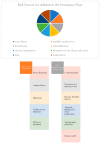Current Trends for Delirium Screening within the Emergency Department
- PMID: 37763753
- PMCID: PMC10537118
- DOI: 10.3390/medicina59091634
Current Trends for Delirium Screening within the Emergency Department
Abstract
Delirium is an acute neurological disorder that involves attention and cognition. It is associated with a high risk of morbidity and mortality among older people (>65 years old). In the context of the Emergency Department (ED), it is frequently experienced by patients but often not recognized. Literature studies have identified some screening instruments for an initial evaluation of delirium. Most of these tools have not been validated yet in the context of emergencies, but, in other settings, they were very useful for assessing and maximizing the recognition of this condition among older patients. We conducted a review of the literature, including randomized control trials, clinical and observational studies, and research studies published in recent years, confirming that most of the screening tools for delirium used in the intensive care unit (ICU) or the geriatric department have not been tested in the ED, and the ideal timing and form of the delirium assessment process for older adults have not been defined yet. The aim of our review is to summarize the updated evidence about the screening tools for delirium in the context of the ED, due to the fact that overcrowding of the ED and the stressful condition of emergency situations (that contribute to the onset of delirium) could expose older patients to a high risk of complications and mortality if delirium is not promptly recognized. In conclusion, we support the evidence that delirium is a current and real condition that emergency physicians have to face daily, and we are aware that more research is needed to explore this field in order to improve the overall outcomes of older patients admitted to the ED.
Keywords: delirium; elderly; emergency department; emergency medicine; pain; screening; sedation; sepsis.
Conflict of interest statement
The authors declare no conflict of interest.
Figures
Similar articles
-
A Lethal Combination of Delirium and Overcrowding in the Emergency Department.J Clin Med. 2023 Oct 18;12(20):6587. doi: 10.3390/jcm12206587. J Clin Med. 2023. PMID: 37892725 Free PMC article. Review.
-
Delirium in older emergency department patients: recognition, risk factors, and psychomotor subtypes.Acad Emerg Med. 2009 Mar;16(3):193-200. doi: 10.1111/j.1553-2712.2008.00339.x. Epub 2009 Jan 20. Acad Emerg Med. 2009. PMID: 19154565 Free PMC article.
-
An assistant workforce to improve screening rates and quality of care for older patients in the emergency department: findings of a pre- post, mixed methods study.BMC Geriatr. 2018 May 30;18(1):126. doi: 10.1186/s12877-018-0811-6. BMC Geriatr. 2018. PMID: 29843623 Free PMC article.
-
Delirium risk prediction, healthcare use and mortality of elderly adults in the emergency department.J Am Geriatr Soc. 2014 Mar;62(3):462-9. doi: 10.1111/jgs.12692. Epub 2014 Feb 10. J Am Geriatr Soc. 2014. PMID: 24512171 Free PMC article.
-
Recognition, prevention, and treatment of delirium in emergency department: An evidence-based narrative review.Am J Emerg Med. 2020 Feb;38(2):349-357. doi: 10.1016/j.ajem.2019.158454. Epub 2019 Oct 8. Am J Emerg Med. 2020. PMID: 31759779 Review.
Cited by
-
A Lethal Combination of Delirium and Overcrowding in the Emergency Department.J Clin Med. 2023 Oct 18;12(20):6587. doi: 10.3390/jcm12206587. J Clin Med. 2023. PMID: 37892725 Free PMC article. Review.
-
The 4AT scale for rapid detection of delirium in emergency department triage.Front Med (Lausanne). 2024 May 14;11:1345983. doi: 10.3389/fmed.2024.1345983. eCollection 2024. Front Med (Lausanne). 2024. PMID: 38808143 Free PMC article.
-
Development and clinical application of an automated machine learning-based delirium risk prediction model for emergency polytrauma patients.Front Physiol. 2025 Jul 14;16:1629329. doi: 10.3389/fphys.2025.1629329. eCollection 2025. Front Physiol. 2025. PMID: 40727448 Free PMC article.
References
-
- Han J.H., Wilson A., Vasilevskis E.E., Shuster J., Ely E.W. Diagnosing delirium in older emergency department patients: Validity and reliability of the delirium triage screen and the brief confusion assessment method. Ann. Emerg. Med. 2013;62:457–465. doi: 10.1016/j.annemergmed.2013.05.003. - DOI - PMC - PubMed
Publication types
MeSH terms
LinkOut - more resources
Full Text Sources
Medical


